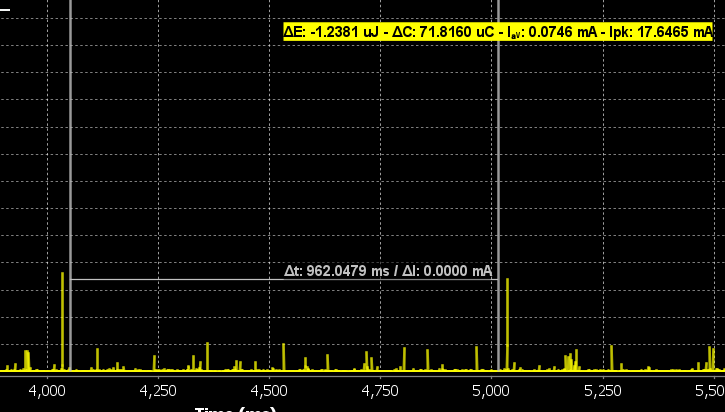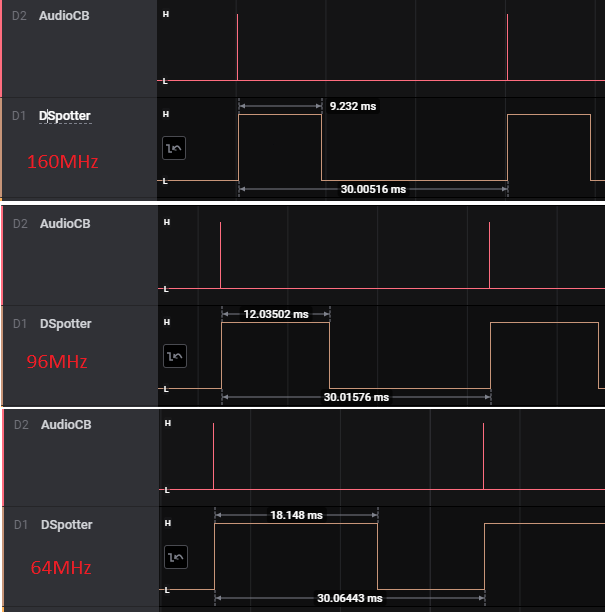11. Performance
11.1. Memory footprint
The memory impact of the DSpotter library on the VAD project is presented in the table below.
Memory space |
Section |
Size / KB |
Address space |
Name |
Comments |
|---|---|---|---|---|---|
FLASH |
.text |
38k |
0x3a264 |
libDSpotter |
The word spotting library |
FLASH |
.text |
95k| |
0x10f50 |
Model/CybModel1.o |
This is the model size with fixed size of keywords (Currently 8) |
RAM |
.bss |
6k |
0x2001b078 |
g_byaRingBuffer |
Cyberon ring buffer to handle audio samples |
RAM |
.bss |
2k |
0x2001a8f4 |
analog_mic_buffer |
Ring buffer for SYS_AUDIO_MGR |
RAM |
22k |
Working memory |
Dynamically allocated from DSpotter software, part of heap. |
11.2. System Power consumption
The equipment and electrical conditions that have been used to perform power consumption measurements were the following:
Daughterboard: D3107_T0, 2206_00038
Motherboard: 500-05-D (RevD)
VLDO set at 3.3v
LCD disconnected
LED functionality disabled
MIC powered at 1.8v
Sleep current for project (all disabled VAD+MIC+LEDs) is ~23uA.
Please consider the sleep current as typical. Users will most likely get different measurements due to slight variations on hw components and hw versions thus measuring other “Sleep current” values.
Sleep current when the VAD and microphone are enabled rises to ~75uA, an increase of ~53uA. The VAD consumes ~5uA, the rest of the increase is caused by the analog microphone (CMM-3729AT-42308-TR), which according to manual has a typical current consumption of 80 µA when powered from VDD = 2.0V.

Figure 20 Power consumption VAD Mic enabled
Consumption during audio sampling is 7.5mA while during word spotting & audio sampling it raises at 17.4mA.

Figure 21 Power consumption during Audio Sampling Word spotting
The table below summarizes these results:
VAD peripheral |
MIC powered |
M33 awake & sampling audio |
M33 awake & sampling audio & running DSpotter lib |
|---|---|---|---|
+5uA |
+48uA |
+7.5mA |
+10mA |
11.3. Timing considerations
11.3.1. DSpotter processing time
For DSpotter library to work properly, a 16KHz sampling rate input is essential. In this application the audio manager is configured to provide 480 samples every ~30ms, thus resulting in a 16k audio data stream. It is valuable to know during the 30ms time period how much time the library word processing consumes. These findings will help to understand why the 160MHz master clock setting was selected for this project.

Figure 22 DSpotter processing time
The signal labeled as “AudioCB” is the callback from the DMA buffer, indicating that samples are ready for processing. The signal “DSpotter” measures the time period the lib consumes to process these audio data.
Master CLK |
Audio Sampling |
DSpotter processing time |
Serial output |
Total processing time |
|---|---|---|---|---|
160 MHz |
30ms |
9ms |
15ms |
24 ms |
96 MHz |
30ms |
12ms |
15ms |
27 ms |
64 MHz |
30ms |
18ms |
15ms |
33 ms |
If “SUPPORT_UART_DUMP_RECORD” macro is enabled the audio samples are printed on serial port. This is an usefull feature during the debugging period of the project. The user can capture the processed audio with the Cyberon tool and compare with the audio input. The table above presents the total processing time including the serial dump of audio samples.
Since a 64MHz master clock would cause an overlapping on Audio sampling periods and total processing time we propose to use at least the 96MHz or even better the 160Mhz to further reduce the possibility of overlapping between sampling periods.

Figure 23 UART Debug processing
As an example, a capture of both events is presented in the above figure. The audio dump (white signal) on serial port trails the DSpotter processing (orange signal). The remaining time until next set of samples is available is 5.7ms.
11.3.2. Wakeup word truncation
As mentioned in the previous chapter, if the “SUPPORT_UART_DUMP_RECORD” macro is enabled, the audio that is processed by DSpotter lib can also be recorded. If the user plays a tune with fixed length into the microphone. The truncated length can be calculated by simply subtracting the fixed length from the recorded length. The difference for this configuration is 10ms.
The 10ms latency is due to the following reasons:
VAD Minimum Event Duration.
Wake-up of the DA1470x system after VAD IRQ is generated
Audio Manager startup
Another factor that should be considered is the DSpotter behavior on startup is that the first samples are treated as initialization data. The next set will be used for word spotting, thus introducing an extra latency to the system of 30ms. The total latency for this particular project would sum-up to 40ms minimum.